中学英语教案-模板合集
中学英语经典教案范文模板
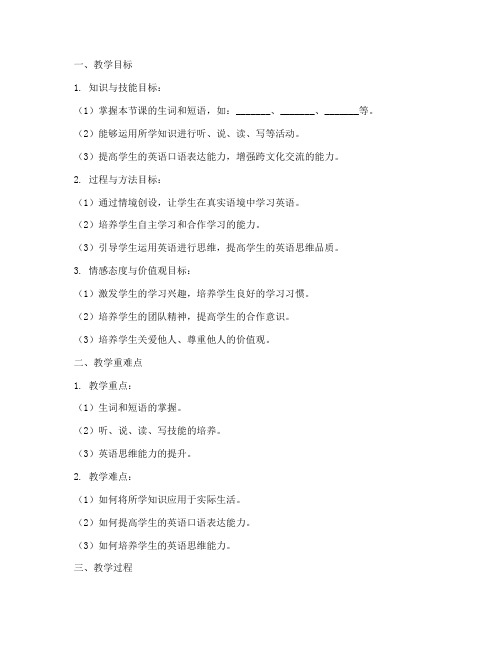
一、教学目标 1. 知识与技能目标: (1)掌握本节课的生词和短语,如:_______、_______、_______等。 (2)能够运用所学知识进行听、说、读、写等活动。 (3)提高学生的英语口语表达能力,增强跨文化交流的能力。 2. 过程与方法目标: (1)通过情境创设,让学生在真实语境中学习英语。 (2)培养学生自主学习和合作学习的能力。 (3)引导学生运用英语进行思维,提高学生的英语思维品质。 3. 情感态度与价值观目标: (1)激发学生的学习兴趣,培养学生良好的学习习惯。 (2)培养学生的团队精神,提高学生的合作意识。 (3)培养学生关爱他人、尊重他人的价值观。 二、教学重难点 1. 教学重点: (1)生词和短语的掌握。 (2)听、说、读、写技能的培养。 (3)英语思维能力的提升。 2. 教学难点: (1)如何将所学知识应用于实际生活。 (2)如何提高学生的英语口语表达能力。 (3)如何培养学生的英语思维能力。 三、教学过程 1. 导入 (1)利用图片、视频等导入新课,激发学生的学习兴趣。 (2)复习上节课所学内容,为新课做好铺垫。 2. 新课呈现 (1)教师讲解生词和短语,引导学生进行跟读。 (2)通过情境创设,让学生运用所学知识进行对话练习。 (3)教师展示例句,引导学生进行仿写。 3. 课堂活动 (1)小组讨论:让学生就某个话题进行讨论,提高学生的口语表达能力。 (2)角色扮演:让学生分组进行角色扮演,巩固所学知识。 (3)游戏环节:设计英语游戏,让学生在轻松愉快的氛围中学习。 4. 巩固练习 (1)教师提问,检查学生对本节课知识的掌握情况。 (2)布置课后作业,巩固所学知识。 5. 总结 (1)教师对本节课所学内容进行总结,强调重点和难点。 (2)鼓励学生课后进行自主学习,提高英语水平。 四、板书设计 (1)生词和短语 (2)句型结构 (3)重点语法知识 五、教学反思 1. 教学效果:本节课是否达到了预期的教学目标? 2. 学生参与度:学生在课堂上的表现如何? 3. 教学方法:教学方法是否合适?是否需要改进? 4. 教学资源:教学资源是否充足?是否需要补充? 六、课后作业 1. 完成课后练习题。 2. 预习下一节课内容。 3. 复习本节课所学知识。 注:以上模板仅供参考,具体教学过程可根据实际情况进行调整。
初中英语教案模板优秀10篇

初中英语教案模板优秀10篇教案是教师课堂教学过程中的重要依据,是教师对于教材的主观理解和感悟,是教学活动正常开展的重要保障。
读书破万卷下笔如有神,下面小编为您精心整理了10篇《初中英语教案模板》,希望能够给您提供一些帮助。
中学英语教案篇八一、教学目标能正确把握表示颜色的单词。
二、教学重点、难点能正确把握表示颜色的单词。
三、教学预备颜色纸或各种实物、单词卡片四、教学过程step 1 revision1、教师出第一课时的三个句型认读。
2.t: what’s this?s: it’s a book.t: what are these?ss: books.t: how many books?s: ??t: is it blue?s: yes.t: is it red?s: no.继续换几种物品提问。
3、出示第二课时的句型订读。
最后的总结。
中学英语教案篇九教学目标:1、会使用可数名词和不可数名词开购物单。
为后两课学习购物做准备。
2、学会讨论吃什么饭,买什么东西。
3、复习一些礼貌用语和习惯表达,如:How about…?What about…?Can you come with me? What do you have for dinner this evening? Let me and have a look.等。
教学用具:录音机,实物投影仪,图片或实物等。
如有条件可做一商店的模型。
是的可更加生动真实。
教学步骤:Step 1 Revision[课件展示]值日生Duty Report。
教师让学生看图片编对话,两人一组操练对话。
同时教师总结售货员用语和顾客用语。
A: May I help you ?B: Thank you. I want …of …,please.A: Certainly. Here you are. Is that all?B: No. And some… please.A: How many do you want?B: About…,please.Step 2 Read and act[课件展示]教师可以点击图片播放影片让学生观看。
初中英语教案(优秀7篇)
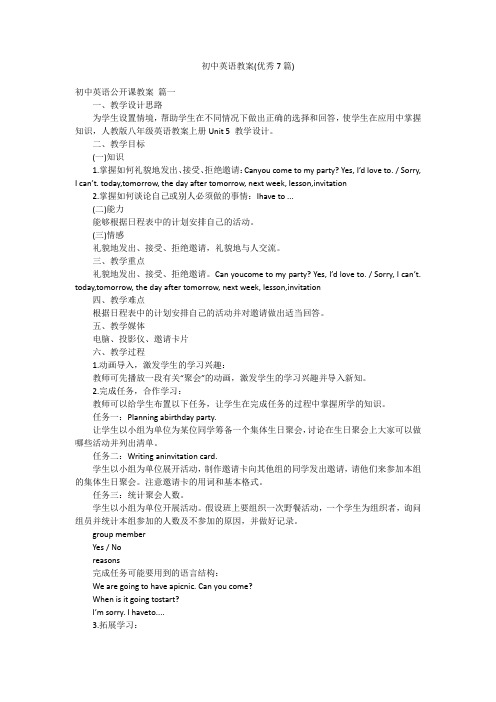
初中英语教案(优秀7篇)初中英语公开课教案篇一一、教学设计思路为学生设置情境,帮助学生在不同情况下做出正确的选择和回答,使学生在应用中掌握知识,人教版八年级英语教案上册Unit 5 教学设计。
二、教学目标(一)知识1.掌握如何礼貌地发出、接受、拒绝邀请:Canyou come to my party? Yes, I’d love to. / Sorry,I can’t. today,tomorrow, the day after tomorrow, next week, lesson,invitation2.掌握如何谈论自己或别人必须做的事情:Ihave to ...(二)能力能够根据日程表中的计划安排自己的活动。
(三)情感礼貌地发出、接受、拒绝邀请,礼貌地与人交流。
三、教学重点礼貌地发出、接受、拒绝邀请。
Can youcome to my party? Yes, I’d love to. / Sorry, I can’t. today,tomorrow, the day after tomorrow, next week, lesson,invitation四、教学难点根据日程表中的计划安排自己的活动并对邀请做出适当回答。
五、教学媒体电脑、投影仪、邀请卡片六、教学过程1.动画导入,激发学生的学习兴趣:教师可先播放一段有关“聚会”的动画,激发学生的学习兴趣并导入新知。
2.完成任务,合作学习:教师可以给学生布置以下任务,让学生在完成任务的过程中掌握所学的知识。
任务一:Planning abirthday party.让学生以小组为单位为某位同学筹备一个集体生日聚会,讨论在生日聚会上大家可以做哪些活动并列出清单。
任务二:Writing aninvitation card.学生以小组为单位展开活动,制作邀请卡向其他组的同学发出邀请,请他们来参加本组的集体生日聚会。
注意邀请卡的用词和基本格式。
任务三:统计聚会人数。
教案简案模板英语初中(3篇)

第1篇课程名称:______(如:英语八年级上册Unit 1 My family)教学目标:1. 知识与技能:a. 学生能够听懂并正确使用本单元出现的核心词汇和句型。
b. 学生能够运用所学词汇和句型进行简单的日常交流。
c. 学生能够阅读并理解与本单元主题相关的阅读材料。
2. 过程与方法:a. 通过听、说、读、写等多种活动,提高学生的英语综合运用能力。
b. 通过小组合作学习,培养学生的团队合作精神和沟通能力。
3. 情感态度与价值观:a. 培养学生对家庭关系的认识和尊重。
b. 增强学生的文化意识,了解西方国家的家庭文化。
教学重点:1. 本单元核心词汇和句型的掌握。
2. 家庭成员关系的表达。
教学难点:1. 家庭成员关系的描述方式。
2. 家庭文化差异的理解。
教学准备:1. 多媒体课件或实物教具。
2. 英语教材和练习册。
3. 学生准备:预习本单元内容,准备相关话题的讨论。
一、导入(5分钟)1. 通过图片或视频展示家庭成员,激发学生的兴趣。
2. 引导学生思考:What's your family like? 引导学生用英语描述自己的家庭。
二、新课学习(25分钟)1. 词汇学习:a. 展示本单元核心词汇,如:father, mother, brother, sister, etc.b. 通过游戏、练习等方式,让学生学会使用这些词汇。
2. 句型学习:a. 引导学生学习本单元核心句型,如:My father is a teacher. My mother is a doctor.b. 通过情景模拟、对话练习等方式,让学生熟练运用这些句型。
3. 阅读理解:a. 提供与本单元主题相关的阅读材料。
b. 引导学生阅读,并回答相关问题。
三、巩固练习(15分钟)1. 完成教材中的练习题,巩固所学知识。
2. 小组合作,进行角色扮演,模拟家庭场景。
四、总结与反思(5分钟)1. 回顾本节课所学内容,强调重点和难点。
2. 引导学生反思自己的学习过程,提出改进意见。
中学英语教案模版

中学英语教案模板一、教学目标1. 知识目标:学生能够掌握本节课的重点词汇和短语。
学生能够理解并运用本节课的主要语法点。
学生能够听懂、说清、读懂日常生活中的英语对话或短文。
2. 能力目标:学生能够通过pr work, group work等形式提高口语交际能力。
学生能够通过阅读、写作等方式提高英语应用能力。
3. 情感目标:学生能够积极参与课堂活动,提高学习英语的兴趣。
学生能够树立自信,勇于开口说英语。
二、教学内容1. 词汇和短语:列出本节课需要掌握的词汇和短语,并给出例句。
2. 语法点:简要介绍本节课的主要语法点,并给出示例。
3. 对话或短文:提供本节课要学习的对话或短文,并给出相关问题。
三、教学步骤1. 热身活动:通过简单的英语游戏或歌曲,调动学生的学习积极性。
2. 引入新课:介绍本节课的主题,引导学生进入学习状态。
3. 新课教学:讲解本节课的词汇、短语和语法点,并通过例句进行说明。
4. 课堂练习:通过小组活动、游戏等形式,让学生巩固所学知识。
四、课后作业1. 抄写本节课的词汇和短语,并造句。
2. 完成本节课的练习题。
3. 预习下节课的内容。
五、教学评价1. 课后收集学生的作业,检查他们对本节课词汇、短语和语法点的掌握情况。
2. 在下一节课开始时,进行课堂测试,了解学生对本节课内容的掌握程度。
3. 观察学生在课堂上的表现,了解他们的学习兴趣和积极性。
六、教学资源1. 教材:使用《新目标英语》或其他适合的教材。
2. 课件:制作精美的PPT课件,辅助讲解和展示教学内容。
3. 实物道具:准备与本节课主题相关的实物道具,增强学生的直观感受。
4. 音频材料:收集与本节课内容相关的音频材料,如英语歌曲、对话等。
七、教学方法1. 任务型教学法:通过小组任务、角色扮演等形式,让学生在实际情境中运用英语。
2. 交际法:鼓励学生积极参与课堂对话,提高口语交际能力。
3. 情境教学法:创设真实的教学情境,激发学生的学习兴趣。
中小学英语教案模板(6篇)
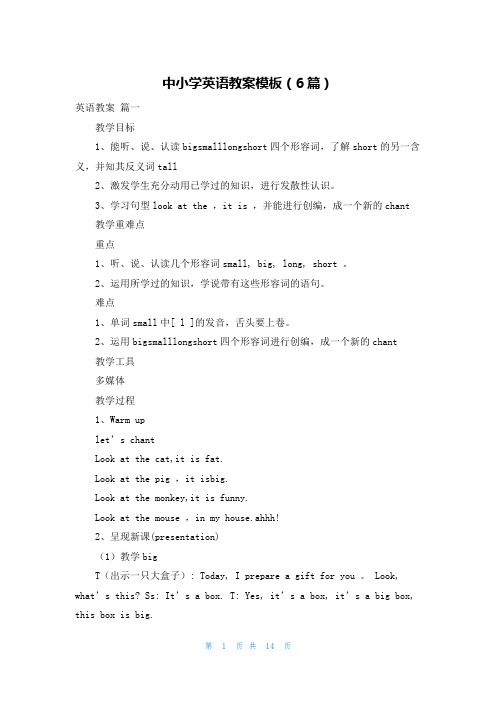
中小学英语教案模板(6篇)英语教案篇一教学目标1、能听、说、认读bigsmalllongshort四个形容词,了解short的另一含义,并知其反义词tall2、激发学生充分动用已学过的知识,进行发散性认识。
3、学习句型look at the ,it is ,并能进行创编,成一个新的chant教学重难点重点1、听、说、认读几个形容词small, big, long, short 。
2、运用所学过的知识,学说带有这些形容词的语句。
难点1、单词small中[ l ]的发音,舌头要上卷。
2、运用bigsmalllongshort四个形容词进行创编,成一个新的chant教学工具多媒体教学过程1、Warm uplet’s chantLook at the cat,it is fat.Look at the pig ,it isbig.Look at the monkey,it is funny.Look at the mouse ,in my house.ahhh!2、呈现新课(presentation)(1)教学bigT(出示一只大盒子): Today, I prepare a gift for you 。
Look, what’s this? Ss: It’s a box. T: Yes, it’s a box, it’s a big box, this box is big.出示单词卡,学习big. B b b bigCAI(出示许多大的物品,让学生练说)a big _____Look at _______.It is big._______is big.(2)教学smallT: Look at the big box. There is something in it 。
Please, guess what’s in it? Ss:……。
T: Look ,it’s a box, too. It’s a small box. The box is small.出示单词卡,学习small sm all small操练:a small _____Look at _______.It is small._______is small.(3)CAI: Can you say?_____________is big ,____________is small(4)教学long and shortT: What’s in the small box 。
初中英语教案模板4篇

初中英语教案模板4篇Junior high school English teaching plan template初中英语教案模板4篇前言:英语作为在许多国际组织或者会议上都是必需语言,几乎所有学校选择英语作为其主要或唯一的外语必修课。
英语教学涉及多种专业理论知识,包括语言学、第二语言习得、词汇学、句法学、文体学、语料库理论、认知心理学等内容。
本教案根据英语课程标准的要求和教学对象的特点,将教学诸要素有序安排,确定合适的教学方案的设想和计划、并以启迪发展学生智力为根本目的。
便于学习和使用,本文档下载后内容可按需编辑修改及打印。
本文简要目录如下:【下载该文档后使用Word打开,按住键盘Ctrl键且鼠标单击目录内容即可跳转到对应篇章】1、篇章1:《Unit 5 Lesson 37》2、篇章2:《Im watching TV》3、篇章3:《Our Local Area》4、篇章4:《Unit 3 Why do you like》篇章1:《Unit 5 Lesson 37》Good morning, everyone,Today, it’s a pleasure for me to stand here and I’m very pleased to havesuch an opportunity to share some of my teaching ideas with you. First, let meintroduce myself. My name is Guo Xinzhi, and I am working as an English teacherin Yong’an Middle School, Congtai District of Handan.My topic today is taken from Lesson 37 of Unit 5 in Student Book 4.Themain content of this unit is “Go With Transportation”, and the topic of Lesson37 is “Flying Donuts”. I have decided to say the lesson from six parts:Part One —— Analysis of the Teaching MaterialOne: Status and Function1.This unit tells us the improvement of traffic transportation and therelated stories. Besides learning this, students will also learn some words,phrases and expressions of traffic, and so on. In Lesson 37, Danny willintroduce a new type of transportation to us, it is imaginary.2.To attain “four skills” request of listening, speaking, reading andwriting, I will have the students do some exercise about the text.3.Such a topic is very important in this unit. I will lead the students touse their imagination and encourage them to be creative. For example, helpingthem use English to describe their imaginary transportation. So I think if thestudents can learn this lesson well, it will be helpful to make them learn therest of this unit.4.While teaching them, I will also encourage them to say something aboutwhat they think the future transportations will be like. In a way, frompractising such a topic, it can be helpful to raise learning interests ofstudents and it will be also helpful to improve their spoken language.Two: Teaching Aims and DemandsThe teaching aim's basis is established according to Junior School Englishsyllabus' provision.1.Knowledge objects(1) To study t he new words “fuel”, “oil” and “coal”.(2)To learn and master the phrases “think of, on the way to …, have fun”,etc.2.Ability objects(1)To develop the students’ abilities of listening, speaking, reading andwriting.(2)To train the students’ ability of working in pairs.(3)To develop the students’ abilities of communication by learning theuseful structures.3.Moral objects(1) Through different teaching methods to make students be interested instudy.(2) Love to know more knowledge about transportation and dare to expresstheir opinions in English.(3) Encourage the students to be more creative and try to makecontributions to making new inventions in the future.Three: Teaching Keys and Difficult PointsThe teaching keys and difficul t points’ basis is established according toLesson 37 in the teaching material's position and function.1.Key points:(1).Be able to express words, phrases and sentences in English.(2). Know about the improvement of transportation and Danny’sinvention.2.Difficult points:Be able to talk about their imaginary future transportation in oralEnglish.Part Two —— The Teaching Methodsmunicative teaching method;2.Audio-visual teaching method;3.Task-based teaching method;4.Classified teaching method.As we all know: the main instructional aims of learning English in theMiddle School is to cultivate students’ abilities of listening, speaking,reading, writing and their good sense of the English language. So in this lessonI’ll mainly use “Communicative” teaching method, “Audio-visual” teaching methodand “Task-based” teaching method and “Classified” teaching method. That is tosay, I’ll let the students get a better understanding of the key structures.I’ll give the students some tasks and arrange some kinds of activities, liketalking, watching CAI, and reading in roles.In a word, I want to make the students the real masters in class while theteacher himself acts as director. I also hope to combine the language structureswith the language functions and let the students receive some moral educationwhile they are learning the English language.Part Three —— Studying ways1.Teach the students how to be successful language learners.2.Make situation and provide meaningful duty, encourage the students tostudy the text by themselves.Part Four —— Teaching stepsAs this lesson plays an important part in the English teaching of thisunit, I have decided the following steps to train their ability of listening,speaking, reading and writing, especially reading and speaking ability.The entire steps are:Step1 Warm-up and Lead-inShow the students some pictures of common transportations, like car, bike,train and so on. Ask the students: What can you see from the picture? Is thereanother kind of transportation around us?Purpose of my designing: In this part, have the students say more aboutwhat they see or what they don’t see. In this way, they will know today’s lessonhas something to do with their discussion.Step2 Presentation1.Learn new words in groups. The new word in this lesson are fuel, oil andcoal. Show them pictures of these things and teach them these new words.Purpose of my designing: After seeing the pictures, the students will knowwhat they are and they can learn them quickly and easily.2.Play the tape recorder. Let the students listen and imitate the text.Pay attention to their pronunciation and intonation. Then finish the exerciseson the computer.Purpose of my designing: This step is employed to make the students get thegeneral idea of the text. At the same time let the students have a chance topractise their listening and speaking ability.3.Text Learning and a QuizI’ll use CAI to present the whole text. I’ll write the key points on theblackboard while they are watching. After watching,I’ll teach them to read thewords and sentences on the Bb. Make sure they can read them well.After teaching them the whole text, including the meanings of new words,the use of similar expressions and so on. Get the students to try and say outsome phrases on the screen, like I don’t think so, have fun, a new kind of, onthe way to school, and so on.Purpose of my designing: To present the text by CAI is much easier for thestudents to learn and grasp the meanings. CAI can provide a real situation withits sound and picture and it makes the relationships between the studentsbetter.4.Key Structures and Difficult Points LearningFirst, I will divide the students into three groups and tell them to have adiscussion about what they learn in this lesson. Then encourage them to try tounderstand the whole text, know what the difficult points are, and so on. Atlast, I will help them to master them all.For example, I teach the students know the differences between phrasesthink of, think about and think over. I will show them some sentences and getthem to know the use of these phrases. Encourage them to do some exercise aboutthese phrases.Purpose of my designing: By practising using these new words and similarphrases, the students will know how to use them in English and master the use ofthem better.5.Read and SayGive the students two or three minutes to prepare, and then get them readthe text together in three groups. Tell them to read aloud.Then help the students say something about the future transportation ortheir imaginary transportation. Encourage them to say more.Purpose of my designing: By reading the text and saying such things, getthe students to practise their reading and speaking ability again.Part Five —— Summarize and HomeworkAsk the students such questions:What have we learned from this lesson? What does Danny say about his newkind / type of transportation? Do you like his idea? What new phrases have welearned today? Do you have enough confidence to finish these exercises? Now,let’s try!Then show them some exercises and help them to finish them.At last, tell the students what today’s homework is. While doing this, theteacher can have the boys and girls have a competition to see who arebetter.Part Six —— Blackboard DesigningLesson 37 Flying DonutsLanguage points:1.think of认为,想起; think over仔细考虑; think out想出2.at/in the front of在……前面(部)/ in front of 在……前面3.on the way to school在上学的路上/ on one’s way home在回家路上4.With用……篇章2:《Im watching TV》【按住Ctrl键点此返回目录】一、教学目标1.知识目标:1)词汇Clean, on, read, apartmentwatching TV, eating dinner, cleaning, shopping, reading, doing homework,talking on the phone2)语法现在进行时(Present progressive tense)3)句子What are you doing? I’m watching TV.What’s he doing? He’s doing his homework.What are they doing? They’re cleaning the room.2.能力目标:学会用英语谈论人们正在做什么(To freely talk about or learn about what they are doing)3.文化目标:培养用英语获取信息,与人合作的能力。
中学英语教案模板教案范文
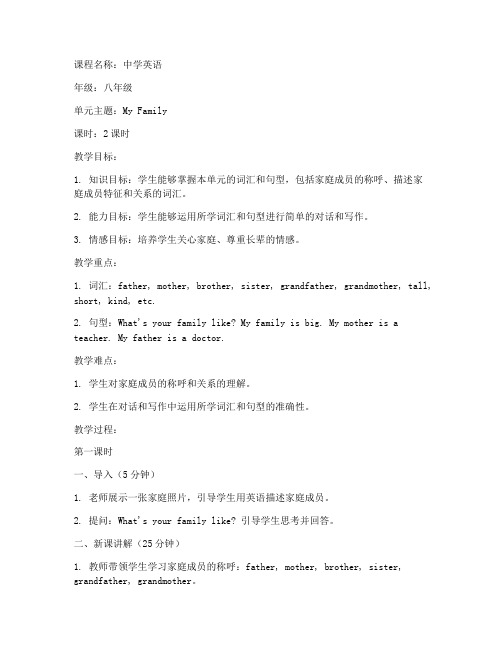
课程名称:中学英语 年级:八年级 单元主题:My Family 课时:2课时 教学目标: 1. 知识目标:学生能够掌握本单元的词汇和句型,包括家庭成员的称呼、描述家庭成员特征和关系的词汇。
2. 能力目标:学生能够运用所学词汇和句型进行简单的对话和写作。 3. 情感目标:培养学生关心家庭、尊重长辈的情感。 教学重点: 1. 词汇:father, mother, brother, sister, grandfather, grandmother, tall, short, kind, etc.
2. 句型:What's your family like? My family is big. My mother is a teacher. My father is a doctor.
教学难点: 1. 学生对家庭成员的称呼和关系的理解。 2. 学生在对话和写作中运用所学词汇和句型的准确性。 教学过程: 第一课时 一、导入(5分钟) 1. 老师展示一张家庭照片,引导学生用英语描述家庭成员。 2. 提问:What's your family like? 引导学生思考并回答。 二、新课讲解(25分钟) 1. 教师带领学生学习家庭成员的称呼:father, mother, brother, sister, grandfather, grandmother。 2. 学习描述家庭成员特征的词汇:tall, short, kind, etc. 3. 学习句型:What's your family like? My family is big. My mother is a teacher. My father is a doctor.
4. 学生跟读、模仿,教师纠正发音。 三、课堂练习(15分钟) 1. 学生分组进行角色扮演,运用所学词汇和句型进行对话。 2. 教师巡视指导,纠正发音和语法错误。 四、总结(5分钟) 1. 老师总结本节课所学内容,强调重点词汇和句型。 2. 学生复述所学内容,巩固记忆。 第二课时 一、复习(5分钟) 1. 教师提问:Can you tell me about your family? 2. 学生回答,运用所学词汇和句型描述自己的家庭。 二、新课讲解(25分钟) 1. 教师带领学生学习描述家庭成员关系的词汇:elder, younger, etc. 2. 学习句型:My elder brother is taller than me. My younger sister is shorter than me.
初中英文教学设计模板(精选5篇)

初中英⽂教学设计模板(精选5篇) 作为⼀位⽆私奉献的⼈民教师,时常需要编写教学设计,借助教学设计可以提⾼教学质量,收到预期的教学效果。
你知道什么样的教学设计才能切实有效地帮助到我们吗?以下是店铺精⼼整理的初中英⽂教学设计模板,欢迎⼤家借鉴与参考,希望对⼤家有所帮助。
初中英⽂教学设计篇1 教学⽬标: 1、能听懂、会说、会读、会拼写词汇look for, join, study 2、能听懂、会说、会读⽇常交际⽤语和句型Classes are over. Perhaps they are. I’ll go and join them. Where are you going? I’m going to … 3、培养学⽣乐于助⼈的良好思想品质。
重点难点: 1、四会掌握词汇和句型。
2、能正确理解掌握并运⽤⽇常交际⽤语。
教学过程: ⾸先是准备环节。
在这⼀环节,⽼师与学⽣交谈彼此的爱好,在轻松愉快的氛围中,拉近⽼师与学⽣之间的距离,为新授课的学习打下良好的铺垫。
其次是复习兼新授(单词与句型的学习)环节。
这⼀环节包括两个步骤,⼀通过看动画图⽚来复习“现在进⾏时”的特殊疑问句,帮助学⽣进⼊这⼀时态的学习⽽做好准备。
⼆以“猜猜看”的游戏来帮助学⽣重温了“现在进⾏时”的⼀般疑问句,在这个过程中引出新单词和句型的学习并进⾏相应的操练,提前把课⽂中的难点解决掉,为下⾯的课⽂学习扫除障碍。
接着是课⽂学习环节。
通过观看课⽂动画⽚,让学⽣做相应的练习来理解和学习朗读课⽂。
然后是巩固环节。
这个环节分三步,第⼀步是以不同的⽅式来让学⽣熟读课⽂。
第⼆步是训练培养学⽣听的能⼒,完成练习“Listen and match”。
第三步是训练培养学⽣写的能⼒,完成练习“Look, read and complete”。
初中英⽂教学设计篇2 ⼀、教学⽬标: 1. 语⾔知识⽬标: 1) 能掌握以下单词: rain, windy, cloudy, sunny, snow, weather, cook, bad, park,message, take a message, could, back, problem 能掌握以下句型: ① —How's the weather in Beijing? —It's sunny. ② —Can I take a message for him? —Yes. Could you just tell him to call me back? —Sure, no problem. 2) 能⽤所学的知识描述天⽓情况。
初中英语教案模板

1 初中英语教案模板 初中英语教案模板(5篇) 规划师生之间的互动形式,如提问、回答、讨论等,以促进学生的参与和思考。同时,明确评价学生学习成果的方法和标准。下面给大家分享初中英语教案模板,欢迎阅读! 初中英语教案模板精选篇1 教材分析 教材内容:新目标初中英语七上Unit1My name is Gina page 1-2 教材处理:本单元的重点在于如何在一个新的场合下介绍自己和认识他人。让刚入学不久的初中新生用英语搭建起他们友谊的桥梁。学会用“What’s your name? / What’s her name? / What’s his name?”以及复习Starter U1-3 所学过的一些common English Greetings 来结识朋友。本课生词量不大,重点在于对学生的口语操练以及常用人名的熟悉。 学情分析 本单元的主题是熟识新伙伴,同时引导学生采用Practicing, Listening for specific information和Role playing的学习策略,学习一些新词汇,掌握一些重点句型,在小组合作学习的过程中,进一步促进学生之间的相互了解。 教学目标 知识与能力 采用Practicing, Listening for specific information和Role playing的学习策略,使学生学会打招呼和介绍自己、询问他人姓名的基本句型What’s your/his/her name?My/His/Her name is…。”培养学生结交新朋友的能力。 过程与方法 采用Practicing, Listening for specific information和Role playing的学习策略,利用教学图片或制作多媒体课件展开课堂Pair work; Group work的口语交际活动,询问他人姓名、查询电话号码,了解有关姓名的文化知识并制作个性名片。 情感态度价值观 2
中学英语教学教案范例模板

---课程名称:高中英语课题: Unit 4 Great Cities课时: 2课时教学目标:1. 知识目标:- 掌握并运用有关城市介绍的词汇和短语。
- 理解并掌握描述城市特点的句型结构。
2. 技能目标:- 能够听懂关于城市介绍的听力材料。
- 能够用英语进行简单的城市介绍。
- 能够通过小组合作,运用所学知识介绍自己熟悉的城市。
3. 情感目标:- 培养学生对英语学习的兴趣和积极性。
- 增强学生对不同文化的理解和尊重。
教学重点:- 词汇和短语的学习与运用。
- 句型结构的掌握和运用。
教学难点:- 听力材料的理解。
- 用英语进行城市介绍的表达能力。
教学准备:- 多媒体课件- 听力材料- 学生分组教学过程:第一课时一、导入(5分钟)1. 教师展示世界地图,提问:“Do you know any famous cities in the world?” 引导学生思考并回答。
2. 引入课题:“Today, we are going to learn about some great cities.”二、词汇教学(15分钟)1. 展示城市相关词汇,如:capital, famous, landmark, museum, etc.2. 通过图片、实物或情境教学,帮助学生理解和记忆这些词汇。
3. 学生进行词汇接龙游戏,巩固词汇。
三、句型教学(10分钟)1. 教师展示描述城市特点的句型,如:“The city is famous for...”, “Ithas a lot of...”, “There are many...”2. 学生跟读并模仿,练习句型。
四、听力训练(15分钟)1. 播放听力材料,学生听后回答问题。
2. 教师点评并解释听力材料中的关键信息。
五、小结(5分钟)1. 回顾本节课所学的词汇和句型。
2. 鼓励学生在课后练习。
第二课时一、复习(5分钟)1. 回顾上一节课所学的词汇和句型。
2. 学生进行小组练习,用所学知识介绍自己熟悉的城市。
初中英语备课教案模板【优秀7篇】
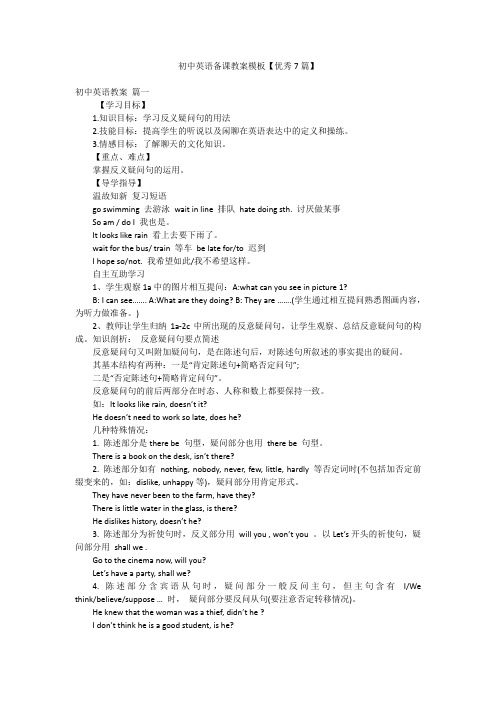
初中英语备课教案模板【优秀7篇】初中英语教案篇一【学习目标】1.知识目标:学习反义疑问句的用法2.技能目标:提高学生的听说以及闲聊在英语表达中的定义和操练。
3.情感目标:了解聊天的文化知识。
【重点、难点】掌握反义疑问句的运用。
【导学指导】温故知新复习短语go swimming 去游泳wait in line 排队hate doing sth. 讨厌做某事So am / do I 我也是。
It looks like rain 看上去要下雨了。
wait for the bus/ train 等车be late for/to 迟到I hope so/not. 我希望如此/我不希望这样。
自主互助学习1、学生观察1a中的图片相互提问:A:what can you see in picture 1?B: I can see……. A:What are they doing? B: They are …….(学生通过相互提问熟悉图画内容,为听力做准备。
)2、教师让学生归纳1a-2c中所出现的反意疑问句,让学生观察、总结反意疑问句的构成。
知识剖析:反意疑问句要点简述反意疑问句又叫附加疑问句,是在陈述句后,对陈述句所叙述的事实提出的疑问。
其基本结构有两种:一是“肯定陈述句+简略否定问句”;二是“否定陈述句+简略肯定问句”。
反意疑问句的前后两部分在时态、人称和数上都要保持一致。
如:It looks like rain, doesn’t it?He doesn’t need to work so late, does he?几种特殊情况:1. 陈述部分是there be 句型,疑问部分也用there be 句型。
There is a book on the desk, isn’t there?2. 陈述部分如有nothing, nobody, never, few, little, hardly 等否定词时(不包括加否定前缀变来的,如:dislike, unhappy等),疑问部分用肯定形式。
中学英语教案模板范文
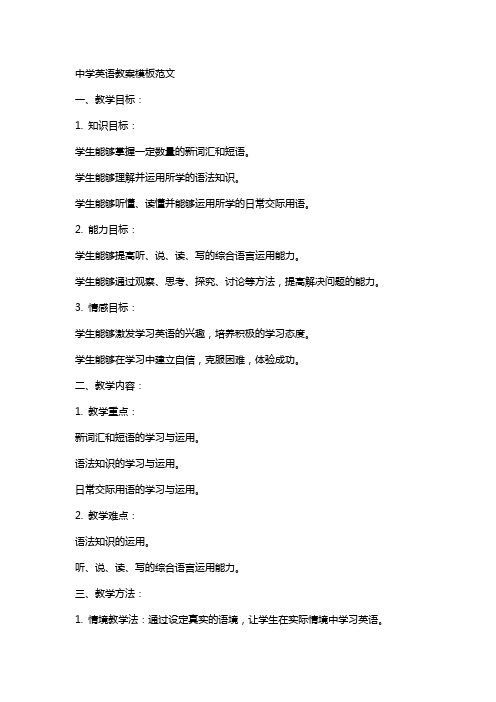
中学英语教案模板范文一、教学目标:1. 知识目标:学生能够掌握一定数量的新词汇和短语。
学生能够理解并运用所学的语法知识。
学生能够听懂、读懂并能够运用所学的日常交际用语。
2. 能力目标:学生能够提高听、说、读、写的综合语言运用能力。
学生能够通过观察、思考、探究、讨论等方法,提高解决问题的能力。
3. 情感目标:学生能够激发学习英语的兴趣,培养积极的学习态度。
学生能够在学习中建立自信,克服困难,体验成功。
二、教学内容:1. 教学重点:新词汇和短语的学习与运用。
语法知识的学习与运用。
日常交际用语的学习与运用。
2. 教学难点:语法知识的运用。
听、说、读、写的综合语言运用能力。
三、教学方法:1. 情境教学法:通过设定真实的语境,让学生在实际情境中学习英语。
2. 交际教学法:通过模拟交际场景,让学生在实际交流中提高英语运用能力。
3. 任务型教学法:通过完成各种任务,让学生在实践中学习英语。
四、教学步骤:1. 热身活动(5分钟):通过简单的歌曲、游戏等活动,让学生放松身心,调动学习积极性。
2. 新课导入(10分钟):讲解新词汇和短语,介绍语法知识,引导学生进行学习。
3. 课堂活动(20分钟):通过模拟交际场景、小组讨论等形式,让学生在实际交流中运用所学的词汇、语法和交际用语。
4. 练习与反馈(10分钟):让学生进行听力、口语、阅读和写作的练习,教师及时给予反馈和指导。
5. 总结与作业布置(5分钟):对本节课的学习内容进行总结,布置适量的作业,巩固所学知识。
五、教学评价:1. 课堂表现:观察学生在课堂上的参与程度、态度表现等。
2. 作业完成情况:检查学生作业的完成质量、速度等。
3. 测试成绩:定期进行听、说、读、写的测试,评估学生的学习成果。
4. 小组合作:评估学生在小组活动中的合作态度、贡献程度等。
六、教学资源:1. 课本:选择一本适合中学阶段的英语教材,如《新概念英语》、《牛津英语》等。
2. 辅助教材:提供一些辅助教学材料,如词汇卡片、语法练习册、听力材料等。
中学英语教案模板英文3篇

中学英语教案模板英文3篇中学英语教案模板英文1Unit 16 Lesson 63Hello, everyone. Today I’m very pleased to have an opportunity to talk about some of my teaching ideas. My topic is life in the oceans taken from Lesson 63 of Unit 16 in SEFC(2). It is made up of four parts.Part 1 My understanding of this lessonThe analysis of the teaching material:This lesson is a reading passage. It plays a very important part in the English teaching of this unit. Lesson 62 and Lesson 63 are a whole unit. By studying Lesson 63, Ss can improve their reading ability, learn more about the sea and the life in the oceans. At the same time, we should get the students to understand some difficult sentences to prehend the passage better. The Ss should do some listening, speaking and writing, too. Of course, the Ss should receive some moral education. Let the Ss understand the sea better, love the sea and save the sea and the life of the sea.Teaching aims:1. Knowledge aim: Understand the main idea of the text.2. Ability aim: Retell the text in their own words.3. Emotional aim: Make the Ss love the life of the sea and do something to stop it being polluted.Key points / Teaching important points:How to understand the text better.Teaching difficult points:1. Use your own words to retell the text.2. Discuss the pollution of the sea and how to save the sea.Something about the Ss:1. The Ss have known something about the sea and sea life through the Internet and other ways.2. They are lack of vocabulary.3. They don’t often us e English to express themselves and municate with others.4. Some Ss are not active in the class because they are afraid of making mistakes.Part 2 My teaching theories, methods and aidsBefore dealing with this lesson, I’ll do my best to carry out the following theories: Make the Ss the real masters in class while the teacher himself acts as director; Combine the language structures with the language functions; Let the students receivesome moral education while they are learning the English language.Teaching method:Double activities teaching methodQuestion-and-answer activity teaching methodWatch-and-listen activityFree discussion methodPair work or individual work methodTeaching aids:1. a projector2. a tape recorder3. multimedia4. the blackboardPart 3. Teaching steps / proceduresI have designed the following steps to train their ability of listening, speaking, reading and writing, especially reading ability.The entire steps are:Greetings, Revision, Lead-in and preparation for reading, Fast reading(scanning), Listening, Intensive reading, Preparation for details of the text, Consolidation, Discussion, Homework Step 1 GreetingsGreet the whole class as usual.Step 2. Revision1. Ask students some questions to revise the last lesson(show them on the screen).a. How much salt do the oceans contain per thousand parts of water?(35 parts of salt. 3.5% by weight)B. What is coral? Why are corals not found in deep water?c. Why is the Dead Sea called the Dead Sea?2. Check the homework(made a survey about the sea or sea life by surfing the Internet or asking for help from other people). Through this part we can consolidate what they studied yesterday, municate with others about their survery results and prepare for the new lesson.Step 3. Lead-in and preparation for readingShow them some pictures and let them talk each other, and then use the pictures about sea and life in the oceans to learn new words, for example, Antarctica, huge whale, sperm whale, squid and so on.Purpose: Arouse the students’ interest of study.Bring in new subject: Life in the oceans.Step 4. Fast readingRead the passage as quickly as they can. I show the questions on the screen and let them get the main idea of each paragraph:1. Why can living things live in such oceans around the Antarctica?2. What does the whale feed on?3. What is the difference between the sperm whale and other whales?Method: Read the text individually, use question—and—answer activity.Purpose: Improve the students’ reading ability.Understand the general idea of each paragraph.Step 5. Listening(book closed)2. True or false exercise.(on the screen)Train the Ss’ listening ability and prepare for later exercises.Step 6. Intensive readingRead the passage carefully again and answer some detailed questions on the screen.1. How much does a whale eat at a time?2. Do all the whales feed on small fish?3. How deep can a sperm whale dive?It is also called depth reading or study reading. It meansreading for detailed information.Purpose: Further understand the text (Train further reading ability) to find out some different sentences and details of the text.Step 7. Preparation for details of the text on the screen1. .its heart slows to half its normal speed.Slow-v. to e / make slower.2. ing sound wavePresent participle used as adverbial.3. provide sth. for sb.Provide sb. with sth.4. at a time: each time5. grow to a length of...Purpose: Train the Ss’ ability of understanding and using laguage.Step 8. Consolidation1. Find out the topic sentences.2. Retell the passage according to the topic sentences.Purpose: I want to know if my students understand the whole text really and if they master what I mean to tell them in this class. What’s more, I want to let them have the ability of introducing and analyzing expression. At the same time, I will write down thetopic sentences on the blackboard according to what the students find, so they can retell it easily.Step 9. DiscussionShow them some pictures about the polluted sea and many living things which are in danger and ask them: What are their opinions about it? In order to let them have free choice, I give them another topic: The sea is being polluted. What should they do?Purpose: I mean to give them emotional education. I give them multi-media pictures to arouse their interest of study and their love for life. I mean to make them realize: The sea is in danger!I teach them to do their best to help it and do something from now on. Everyone should do something to love and protect our home.Step 10. HomeworkWrite an article Saving the sea. I want to improve the ability of their writing. At the same time, train the ability of do-it-yourself and looking up the information by themseleves.Part 4. Blackboard designUnit 16 Lesson 63Topic Sentences:1. Some living things can live in Antarctica.(what)2. The whale feeds on small fish.(what)3. The sperm whale feeds on squid.(difference)Discussion:1. The whales are in danger. What’s your opinion about it?2. The sea is being polluted. What should we do?In my opinion, the blackboard design can reflect the teacher’s ability of mastering the text and leading the students to master the text easily.In this text, the design is not easy to write. I write the topic sentences on the blackboard in order to tell the students that this is of the importance in this class. The discussion is of the difficulty.I want to make the design inductive, instructive and artistic.中学英语教案模板英文中学英语教案模板英文2__G __RESI、Warming-upStep one:Let’s the student listen to the tape.And review some adj. about weather.Eg:warm,cool,hot,cold.Let the students do actions while listening.Step two:Do an exercise.The teacher will ask some questions about the listen test.It's about part B read and write in grade five.Eg:What's your favourite 。
中学英语教案模版

中学英语教案模板一、教学目标:1. 知识目标:(1)学生能够掌握单词:hello, world, school, teacher, student, family, friends, love, happy, sad。
(2)学生能够运用所学单词进行简单的自我介绍和日常交流。
2. 能力目标:(1)学生能够听懂并正确回答问候语和介绍自己的句子。
(2)学生能够用英语进行简单的对话交流。
3. 情感目标:(1)学生能够积极参与课堂活动,提高学习英语的兴趣。
(2)学生能够树立自信,勇于开口说英语。
二、教学重点与难点:1. 教学重点:(1)单词:hello, world, school, teacher, student, family, friends, love, happy, sad。
(2)基本句型:介绍自己、询问他人情况。
2. 教学难点:(1)单词的准确拼写和运用。
(2)句型的运用和语法正确。
三、教学方法:1. 情境教学法:通过设置真实的生活情境,让学生在实际语境中学习英语。
2. 互动教学法:引导学生参与课堂活动,进行小组讨论和角色扮演,提高学生的口语表达能力。
3. 游戏教学法:通过趣味游戏,激发学生的学习兴趣,巩固所学知识。
四、教学过程:1. 热身(5分钟):(1)教师与学生用中文进行简单的自我介绍。
(2)学生进行简单的英语问候语练习。
2. 课程导入(10分钟):(1)教师展示一幅图片,引导学生用中文描述图片内容。
(2)教师引导学生用英语描述图片内容,并纠正发音。
3. 新课内容(15分钟):(1)教师讲解单词:hello, world, school, teacher, student, family, friends, love, happy, sad。
(2)学生跟读单词,教师纠正发音。
(3)教师举例运用单词进行简单句型练习:介绍自己、询问他人情况。
4. 课堂活动(10分钟):(1)学生进行小组讨论,用英语介绍自己的家人和朋友。
- 1、下载文档前请自行甄别文档内容的完整性,平台不提供额外的编辑、内容补充、找答案等附加服务。
- 2、"仅部分预览"的文档,不可在线预览部分如存在完整性等问题,可反馈申请退款(可完整预览的文档不适用该条件!)。
- 3、如文档侵犯您的权益,请联系客服反馈,我们会尽快为您处理(人工客服工作时间:9:00-18:30)。
………………………………………………最新资料推荐……………………………………… Basic Information ( 基 本 信 息) Teacher(教师) Stone Type(课型) New Teaching material (教材) EEC Grade six (Book One) Period(课时) 1 class
Teaching Model (教 学 设 计) Contents of teaching (教学内容) Unit 2 They’re going to the opera. Analysis of the teaching material
(教材分析)
The reading passage has so much information, and there are quite a few new words in it. This will help to improve students’ reading skill.
Aims of teaching (教学目标) 1. To get information from reading material about what people are doing in
different places.
2. To get to know how to write a postcard. Emphasis on teaching (教学重点) Reading ability: read for details.
Vocabulary: thing,restaurant,wash,start,hot dog. Key points: put on, at this moment, leave work,at home, get dressed, look at,see you soon
Complementary words: supper, who Difficult sentence: Some are going to the opera orwatching a ballet. (Some are going to see an operaor watch a ballet.) Ideas of design (设计思路) Encourage the students
1. To predict what the text will be about by reading the title by asking the students to read for details. 2. Tofind out how to write a postcard by reading the post card. Teachingprocess (教学流程) Activities of teachers (教师活动) Activities of students (学生活动) Warming up (情景导入/导入新课) Review what they’ve learnt last lesson. 1. Ask Ss to do some actions. 2. The others talk about what they are doing.
Some students would be asked to do some actions.
The others talk about what they are doing.
Presentation (讲授新课) Vocabulary and sentence structure 1.Words guessing 2.Say what the people in the photos are doing.
Students are supposed to match the new words with picture in Part 1 on Page 4, and to be able to read the new words, and then to know the meanings of the words. ………………………………………………最新资料推荐……………………………………… 2 / 5 上课教师 Name 学生年级 初一 教材 《英语》(新标准) 课时 一课时 教 学 设 计 教学内容 Unit 2 They’re going to the opera.
教材分析 The reading passage has so much information, and there are quite a few new words in it. This will help to improve students’ reading skill.
教学目标 To get information from reading material about what people are doing in different places.
To get to know how to write a postcard.
Practice (情景操练/巩固练习) 1. Ask the students to read the title on Page 4 & Part 2 on Page 5, then guess what will the text talk about.
2. After that, ask st8 udents to read and find out information. 3. Then ask students to finish part3 on page5.
Pre-task activity: Pair work Read the title on Page 4. Then discuss in pairs what the text will talk about. After discussion, some students should be asked to tell the whole class about their guessing.
While-task activity 1: Individual work Read the text and underline the words. While-task activity 2: Group work Work in groups to complete Part 2/3 on P5. Post-task activity: Group work Present their answers. Summary (情景回归/归纳总结) Text explanation Discuss the sentences in the text, and
try to get familiar with the words and phrases.
Board design (板书设计) Unit 2 They’re going to the opera.
Key points: watching a ballet. put on, at this moment, leave work,Difficult sentence: at home, get dressed, look at, Some are going to the opera orwatching a ballet. see you soon = Some are going to see an operaor watch a Additional new words: supper, who ballet. Homework (作业布置) 1. Reading on Page 4and page90 2. Buying a new postcard FOR next lesson. Teaching Tool (教具) 1. PPT player & mantle
2. Cards ………………………………………………最新资料推荐………………………………………
3 / 5 教学重点 Reading ability: read for details. Vocabulary: thing,restaurant,wash,start,hot dog. Key points: put on, at this moment, leave work, at home, get dressed, look at, see you soon Additional new words: supper, who Difficult sentence: Some are going to the opera or watching a ballet. (Some are going to see an opera or watch a ballet.)
设计思路 Encourage the students to predict what the text will be about by reading the title ..
Ask the students to read for details. Encourage the students tofind out how to write a postcard by reading the post card.
教师活动 学生活动 教 学 流 程 教 1. 情 景 导 入
Review what they have learned from last lesson. 1. Ask Ss to do some actions. 2. The others talk about what they are doing. Some students would be asked to do some actions.Then the others talk about what they are doing.
